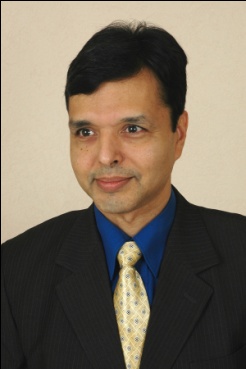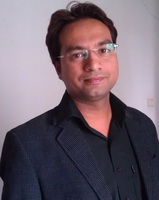应我所所长钱春香教授邀请,澳大利亚科廷大学Abhijit Mukherjee教授携华东师范大学Varenyam Achal副教授将在本院共同举办学术报告,欢迎广大师生积极参加。
报告题目:Path to Sustainable Infrastructure- Monitor, Maintain and Develope
报 告 人:Abhijit Mukherjee教授
报告时间:2014年7月4日下午1点30分
报告地点:材料学院B楼523会议室
 Abhijit Mukherjee教授现为澳大利亚科廷大学土木工程学院教授,曾任印度甘地讷格尔技
Abhijit Mukherjee教授现为澳大利亚科廷大学土木工程学院教授,曾任印度甘地讷格尔技
术学院首席教授,塔帕尔大学土木工程系主任,主要从事于建筑结构的健康监测、评估与修复与
新型结构材料的研发。Mukherjee教授一直关注可持续发展新材料的研究,近年来在利用生物技术
修复混凝土、制备微生物水泥方面取得了突破性的进展,承担的微生物水泥中试生产项目得到印
度科技部的重点支持,为该技术的推广应用做出了卓越贡献,获得国际社会的高度评价。已发表
论文150多篇,被引用超达1500次,为200余项结构工程的修复与重建提供了技术指导。受邀担任
多项国际研究项目的评审专家,包括美国国家科学基金会、联邦教育与研究部、德国以及欧盟等
其它组织,获得了美国土木工程师学会优秀杰出论文奖,并担任印度国家工程院和印度国立科学
院研究员,在国际上具有影响力。
Path to Sustainable Infrastructure- Monitor, Maintain and Develop
Abhijit Mukherjee
Professor of Civil Engineering, Curtin University, Bentley, WA 6102
Abstract: While infrastructure is a basic need for prosperity the present technology for building them is not sustainable. It uses too much energy and emits a large quantity of greenhouse gases. The path to sustainability is not only through making new sustainable structures, but also through proper monitoring and maintenance of existing ones. Recent advances in biotechnology have the potential of emulating nature’s way of building at a scale that would sustain world’s population. On the other hand, developments of communication and sensing technologies promise to offer monitoring of structures at an unprecedented scale. In this talk, a gist of research carried out by Professor Mukherjee on materials, monitoring and maintenance will be presented. The potential of each of the technologies will be mentioned along with the challenges.
报告题目:Microbially Induced Carbonate Precipitation in Soil and Dusts: Implication in Heavy Metals Remediation
报 告 人:Varenyam Achal副教授
报告时间:2014年7月4日下午2点30分
报告地点:材料学院B楼523会议室
 Varenyam Achal博士,师从Abhijit Mukherjee教授,2010年在印度塔帕尔大学获得博士学位后,获得了中国科学院的国际青年科学奖学金,前往中国科学院工作2年,由于表现出色留任中国现于华东师范大学生态与环境科学学院任职副教授。他主要致力于利用微生物矿化形成方解石进行生物修复,如环境污染治理、历史建筑文物修复、微生物混凝土等,获得了中国国家自然科学基金等多项项目资助,2010年获得了美国土木工程师学会优秀论文奖,2013年被列入世界名人录,获得关注。
Varenyam Achal博士,师从Abhijit Mukherjee教授,2010年在印度塔帕尔大学获得博士学位后,获得了中国科学院的国际青年科学奖学金,前往中国科学院工作2年,由于表现出色留任中国现于华东师范大学生态与环境科学学院任职副教授。他主要致力于利用微生物矿化形成方解石进行生物修复,如环境污染治理、历史建筑文物修复、微生物混凝土等,获得了中国国家自然科学基金等多项项目资助,2010年获得了美国土木工程师学会优秀论文奖,2013年被列入世界名人录,获得关注。
Microbially Induced Carbonate Precipitation in Soil and Dusts:Implication in Heavy Metals Remediation
Varenyam Achal, Associate Professor
School of Ecological and Environmental Sciences, East China Normal University, Shanghai, China
Abstract: Ever increasing urban expansion, industrial development and anthropogenic activities are major sources of polluting environment including soils and urban road dusts with heavy metals. Posing with serious environmental problems, heavy metals are the environmental priority pollutants and require ultimate solution for the removal to protect both health and environment. Albeit many reports of such pollution, remediation process for urban road dusts has not been studied and soil remediation has not been much successful. Various physical, chemical and biological methods are used for metals remediation from contaminated soil. The remediation methods either could decontaminate or stabilize the heavy metals. Nevertheless, the physic-chemical remediation technologies are rarely adopted because of many disadvantages associated with them. Recently, microbially induced calcite precipitation (MICP), which also provides an efficient green construction material, has been proposed a promising approach for remediation of various pollutants with advantages on current bioremediation techniques. The ubiquity and importance of microbes in inducing calcite precipitation by producing an enzyme, urease, make MICP active in every environment. This process removes heavy metals from contaminated environment and sequesters as bio-minerals and also facilitates bio-precipitation of metals. The present talk discusses application of such approach in the remediation of heavy metals from contaminated soils of China and also from urban road dusts of different parts of Shanghai, China.
